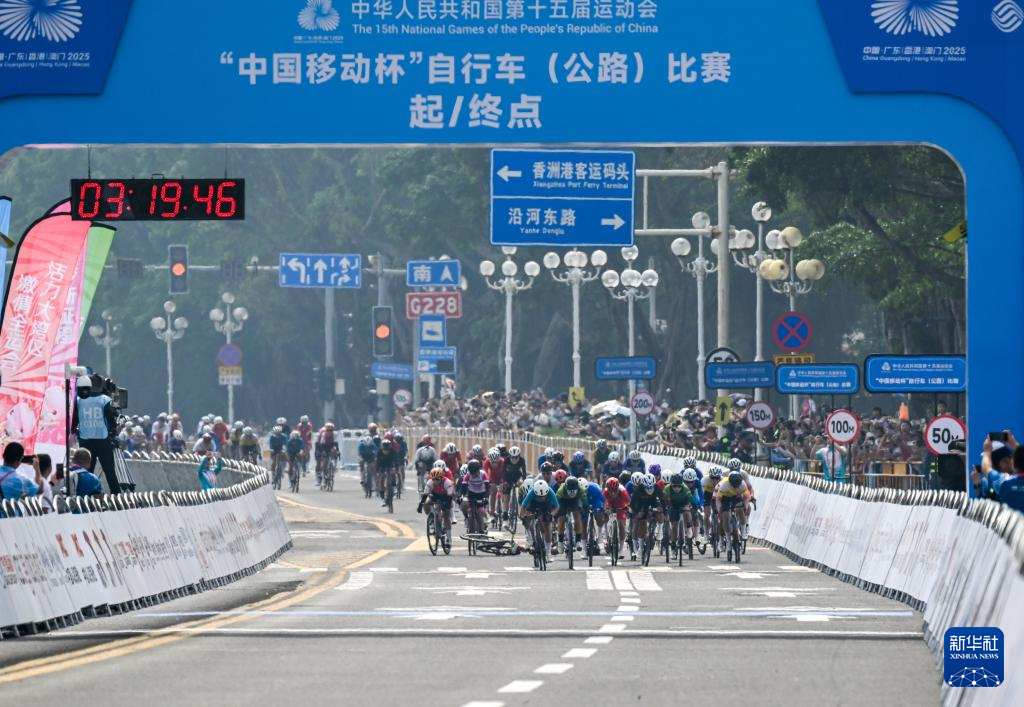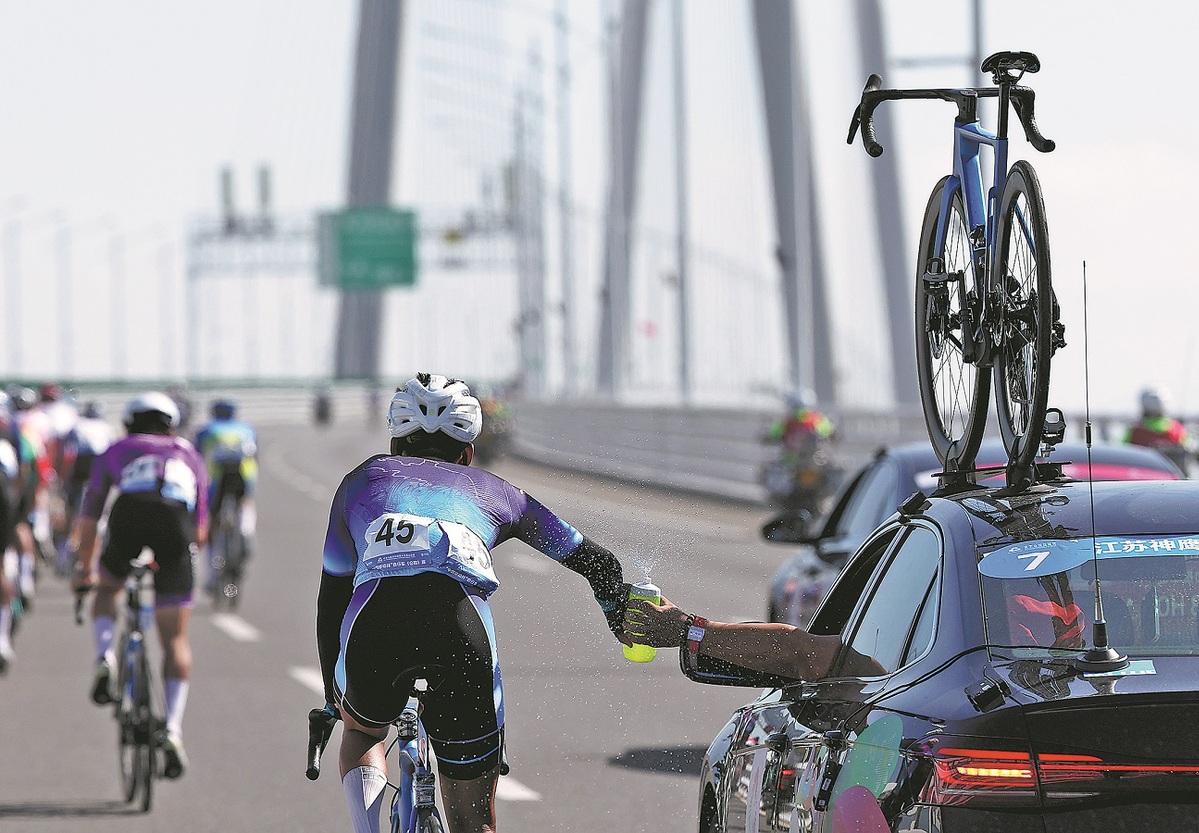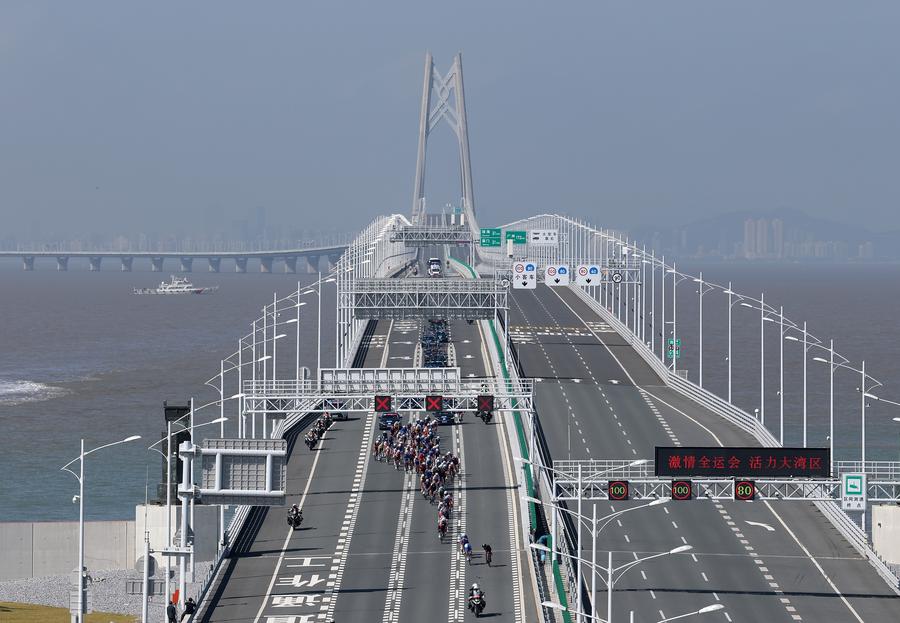
Crowds of people eagerly lined the railings on both sides of the scenic Qinglyu Road in Zhuhai, Guangdong province, on Saturday, as a sea breeze took the edge off the hot day. The spectators were waiting for over 100 competitors in the men's individual road cycling race at the ongoing 15th National Games.
Starting in Zhuhai, then passing through Macao's Taipa Island and Hong Kong's Lantau Island before returning to Zhuhai, the 231.8-kilometer race was a first for the games.
All three games hosts — Guangdong and the Hong Kong and Macao special administrative regions — were linked by a single competition, with riders passing through checkpoints six times without stopping. In the National Games' 66-year history, it was the first staging of a cross-boundary race.
This unique experience for both athletes and spectators was made possible by the ongoing integration in the Guangdong-Hong Kong-Macao Greater Bay Area. In recent years, this integration has been further enhanced by infrastructure development, boosting connectivity and mechanisms that make people-to-people exchanges more convenient.
Macao rider Kam Chin-pok said the event had deepened his understanding of connectivity within the Greater Bay Area.
"It's not just about this competition. Crossing the boundaries is becoming more and more convenient for the public. After the games, I believe people will know more about the Greater Bay Area and how integrated it has become," he said.
Kam, who competed in a trial race in November last year, said the experience of riding across the Hong Kong-Zhuhai-Macao Bridge — which opened in October 2018 — for a second time was still a great thrill.
"The Hong Kong-Zhuhai-Macao Bridge is truly magnificent. Most of the time, we can only travel on it by car. To get this close to the bridge on a bicycle and to feel the wind is a completely different experience, which I think maybe only the National Games could offer," Kam said.

Li Dongyu, who represented Tianjin, echoed Kam's view. He said riding on the bridge was an awe-inspiring experience as the scenery constantly changed, from cityscapes to sea views and tunnels.
"If not for this race, I might never have had the chance to travel between Zhuhai, Hong Kong and Macao, all in just over five hours," said Li, whose role was to collect water and other supplies from the support vehicle for his teammates.
ALSO READ: Shandong's Liu wins first cross-boundary National Games cycling road race
Han Feng, deputy secretary-general of the Chinese Cycling Association, said racing on the bridge — which spans 55 km and is among the world's longest cross-sea bridges — was a bold and challenging concept.
The bridge stands approximately 50 meters above the sea, equivalent to the height of a 20-story building. As cyclists travel at speeds exceeding 40 km per hour amid the vast expanse of sea and sky, the strong sea winds hitting the peloton make maintaining a steady course no easy feat.
"Globally, no cycling race has ever covered 60.8 km on a cross-sea bridge. Despite the difficulty, this will undoubtedly become the highlight of the route," said Han.
Li from Tianjin also praised the efficient organization of the event. "At the crossing checkpoints, staff were waving flags to guide us at each crossing, and there were barriers along the road to prevent crashes. I could feel the support from the event staff in all positions, working to ensure we finished the race safely."

Game of tag
The smooth running of the race involved close cross-boundary coordination and technological innovation.
Min Yuntong, executive deputy director of the Zhuhai executive committee for the National Games, said the most challenging part was to ensure the accuracy and completeness of data. All support vehicles and equipment underwent clearance before the race, Min said.
Radio Frequency Identification readers, connected to the BeiDou Navigation Satellite System, were installed at checkpoints to instantly record athletes' wristband signals via RFID tags. With riders passing through at speeds exceeding 40 km/h, the system guaranteed an uninterrupted race.
Min said the rapid transmission and processing of data meant there were no race delays. "It can handle nearly 200 people passing simultaneously with an upload delay of less than 100 milliseconds. It has ensured the cyclists can pass the checkpoints with zero delay, zero contact and zero waiting time."
The idea of using the radio-frequency identification technology during the race was inspired by clearing private vehicles from Hong Kong and Macao fitted with RFID tags traveling to Guangdong via the Hong Kong-Zhuhai-Macao Bridge. The method ensures the uniqueness and security of access credentials.
Hong Kong team representative Tommy Wu Chun-yin was impressed with the method used for the race. Having registered the athletes' personal information before the race, teams were issued with exclusive wristbands and helmets fitted with multiple RFID tags. Following identity verification through facial recognition and fingerprint checks, participants entered a closed-loop management system for the event.
ALSO READ: National Games enhances coordination under ‘one country, two systems’
"Having the tags placed in various locations meant if one scanner missed a tag, another would pick it up, which I found very important. The wristband is also comfortable and doesn't feel restrictive at all," Wu said.
On Saturday, 103 athletes, along with their bicycles, completed inspection and clearance procedures and put on their wristbands. With the inclusion of support staff, a total of 257 people and 68 support vehicles smoothly went through the process.

Close quarters
At around 10:20 am, the race convoy entered the Hong Kong section of the event. The cyclists then tackled a 55.8-km segment that took them through the Hong Kong Port Artificial Island, the North Lantau Highway, and Penny's Bay Highway. The course offered a unique backdrop as it wound past Hong Kong Disneyland Resort, where athletes made a U-turn before heading back to Zhuhai.
To give the public a front-row seat to the historic occasion, a dedicated viewing area was set up along Fantasy Road near the U-turn. Riders sped past the venue at approximately 11:15 am, greeted by spectators' cheers and applause.
Among them were groups of students, including Form Four student Chloe Yeung, who witnessed a large-scale sporting event up close for the first time.
"It was so exhilarating to see the racers speed past right in front of me," Yeung said. "I knew this was a historic event — the first cross-border race linking Guangdong, Hong Kong, and Macao via the Hong Kong-Zhuhai-Macao Bridge. Seeing so many Hong Kong athletes participating was incredibly thrilling."
She said that such large-scale sports events are rare in Hong Kong.
"Realizing I was witnessing this inaugural cross-boundary event and that I could be here to personally encourage the athletes made me excited," she added. "The atmosphere was fantastic. I hope our school organizes more trips to events like this in the future — I would definitely join."
A teacher surnamed Cheng said that as the riders raced past, it allowed spectators to truly experience the intensity and speed of the event. He said it also helped him appreciate the extensive behind-the-scenes planning that made the race possible.
"Seeing everything, from the cyclists to the full complement of support vehicles, demonstrated a thoroughly well-organized and complete event," he said, adding his school will also take students to watch the rugby sevens event.
Form Five student Yu Xin-shun said that the joint hosting of the games provides an important opportunity to foster greater integration and development within the Greater Bay Area. It also facilitated valuable exchanges among young people.
"For example, having Hong Kong athletes participate in this competition creates meaningful opportunities for exchange," Yu explained. "We can learn from the Chinese mainland's advanced training methods and well-established sports systems, which are widely recognized for their excellence."
The race also attracted enthusiastic spectators on the other side of the border. In Zhuhai, parents brought their children to watch the race, and experience the spirit of the National Games on their doorstep.
Many Hong Kong residents made a special trip north to watch the start of the race. "I specifically came to Zhuhai and stayed overnight just to watch the race, even though it was over in a flash," said a resident surnamed Cheng. "With travel to the mainland being so convenient now, it's also good for a short trip."

Podium places
After over five hours of intense riding, a group of riders surged into view near the finish line in Zhuhai — their colorful jerseys drenched in sweat, pushing speeds of over 40 km/h.
At the front of the pack, several sprinters battled fiercely, teeth gritted, charging toward the finish line near the Zhuhai Museum.
After a nail-biting final sprint, Liu Zhicheng, who represented Shandong province, crossed the finish line first with a time of five hours, 17 minutes, and five seconds. He was followed by Beijing's Xue Chaohua and Yunnan province's Hu Haijie, with the podium places decided by mere centimeters.
Liu highlighted the unique challenge of the cross-boundary race. "The second half was run at a relentless pace, with no one holding back," Liu said at the post-race press conference. "It all came down to an extremely intense final sprint for position."
Liu said his team had prepared strategies to handle the crosswinds on the Hong Kong-Zhuhai-Macao Bridge.
READ MORE: HK cyclist defends her crown, secures city’s second gold
"But during the race, the crosswinds on the bridge weren't actually very strong. The main challenge was the headwind on the way out and the tailwind on the way back," Liu said, adding that support for the event was well-rounded.
"From technology to operations, the whole mechanism of the race has been tested and proven. The pioneering model paves the way for greater integration of sports, culture and tourism across the Greater Bay Area," Min, executive deputy director of the Zhuhai executive committee for the National Games, said.
Eric Chan Kwok-ki, chief secretary for administration of the Hong Kong Special Administrative Region government, said at a news conference on Saturday that the event featured seamless real-time boundary crossings, with well-coordinated services and transportation at each checkpoint, fully showcasing the close cooperation among the governments of the Greater Bay Area.
Another cross-boundary event of the National Games, the marathon, will see athletes run across the Shenzhen Bay Bridge, connecting Shenzhen and Hong Kong, on Nov 15.


